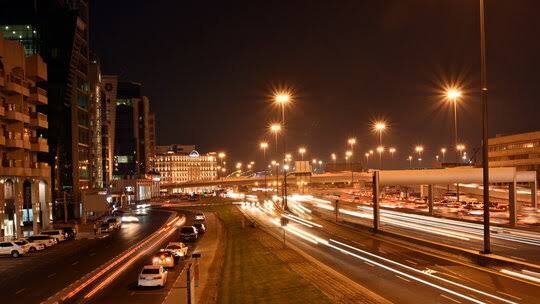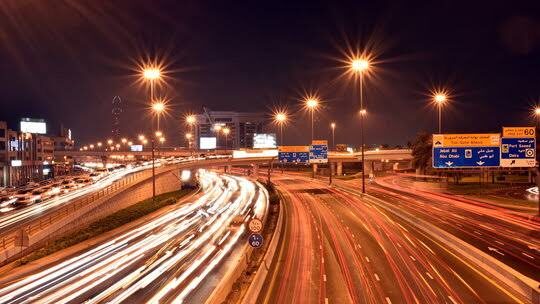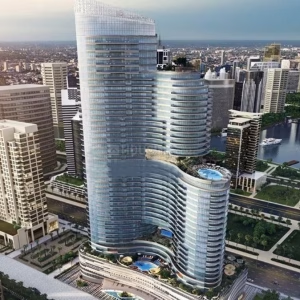Al Ittihad Road, or E11, is one of Dubai’s most prominent and busiest highways, connecting the city to the neighboring emirate of Sharjah. As a vital transportation route, it plays an essential role in facilitating daily commutes, inter-emirate travel, and the movement of goods and services. Stretching through densely populated areas and commercial hubs, Al Ittihad Road is a symbol of Dubai’s urban growth and connectivity.
Historical Context
Before the rapid urbanization of Dubai, the need for efficient roadways was not as pronounced. However, with the city’s exponential growth, Al Ittihad Road emerged as a critical link between Dubai and Sharjah. Over the decades, the road has witnessed significant developments, including expansions and infrastructure upgrades, to accommodate the increasing volume of vehicles.

Strategic Importance
Al Ittihad Road serves as a lifeline for both residents and businesses. Its strategic location makes it indispensable for several reasons:

- Connectivity Between Emirates:
The road connects Dubai to Sharjah, facilitating the daily commute of thousands of residents who live in one emirate and work in the other. - Access to Key Areas:
Al Ittihad Road passes through major residential, commercial, and industrial zones, providing access to critical destinations like Deira, Al Qusais, and Al Nahda in Dubai, as well as Al Majaz and Al Taawun in Sharjah. - Economic Significance:
The road supports the movement of goods and services, contributing to the economic activities of both Dubai and Sharjah.
Infrastructure and Features
Al Ittihad Road is designed to handle heavy traffic volumes and features a range of modern infrastructure elements:
- Multiple Lanes:
The road has multiple lanes in both directions to accommodate a high number of vehicles during peak hours. - Interchanges and Exits:
Well-planned interchanges and exits ensure seamless connectivity to adjoining neighborhoods and arterial roads. - Public Transport Integration:
Al Ittihad Road is well-integrated with Dubai’s public transport network, including bus routes and metro lines, making it accessible for non-motorists. - Pedestrian Crossings:
Several pedestrian bridges and crossings enhance safety for those traveling on foot. - Roadside Amenities:
The road is lined with essential services such as petrol stations, restaurants, and convenience stores, catering to the needs of commuters.
Daily Challenges
Despite its importance, Al Ittihad Road is not without challenges, particularly during peak hours:
- Traffic Congestion:
The road experiences heavy traffic during morning and evening rush hours, as thousands of vehicles commute between Dubai and Sharjah. - Accidents and Delays:
High traffic volumes sometimes result in accidents, leading to delays and congestion. - Commuter Stress:
The daily grind of navigating through traffic can be stressful for regular commuters.
Government Initiatives for Improvement
Recognizing the challenges, authorities have implemented several measures to improve the road’s efficiency and alleviate congestion:
- Expansion Projects:
The road has undergone multiple expansion projects over the years, adding more lanes to accommodate increasing traffic volumes. - Smart Traffic Management:
Advanced traffic monitoring systems have been introduced to manage congestion and ensure smoother flow during peak hours. - Public Transport Enhancements:
Encouraging the use of public transport, such as the Dubai Metro, buses, and shared taxis, helps reduce the number of private vehicles on the road. - Alternate Routes:
Authorities have developed parallel roads and alternate routes, such as Sheikh Mohammed bin Zayed Road and Emirates Road, to distribute traffic and ease the burden on Al Ittihad Road.
Tips for Commuters
Navigating Al Ittihad Road can be challenging, but a few tips can make the journey smoother:
- Plan Ahead:
Check traffic updates before heading out and plan your route accordingly. - Travel Off-Peak:
If possible, avoid traveling during peak hours to minimize delays. - Use Public Transport:
Opt for buses or the Dubai Metro to avoid the hassle of driving during busy times. - Carpooling:
Sharing rides with colleagues or neighbors can help reduce the number of vehicles on the road. - Stay Alert:
Maintain a safe distance from other vehicles and stay focused, especially during heavy traffic.
Future Prospects
As Dubai continues to grow, the importance of Al Ittihad Road will only increase. Future developments may include:
- Further Expansions:
Adding more lanes or dedicated bus lanes to improve traffic flow. - Smart Road Technologies:
Implementing AI-driven traffic management systems to predict and manage congestion. - Sustainability Initiatives:
Introducing green landscaping and solar-powered lighting along the road to enhance sustainability. - Enhanced Public Transport:
Expanding metro and bus services to provide more alternatives for commuters.
A Symbol of Connectivity
Al Ittihad Road is more than just a highway; it is a testament to Dubai’s commitment to connectivity and urban development. Despite the challenges of traffic congestion, it remains a crucial artery that supports the daily lives of countless residents and businesses.
As Dubai and Sharjah continue to evolve, Al Ittihad Road will undoubtedly remain at the heart of inter-emirate connectivity, adapting to meet the needs of a growing population and dynamic economy. For those who traverse this road daily, it represents not just a route, but a lifeline connecting people, places, and possibilities.
Do follow Uae stories for more Updates













